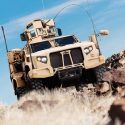Compact UV lasers could identify substances from a distance
For soldiers in the field, the ability to identify an object or substance based on how it responds to light could mean the difference between life and death. They could, for example, determine from a safe distance if an approaching person or vehicle is carrying an explosive device or dangerous biological agent.
Ultraviolet lasers are key to such technology. However, a laser system that sophisticated currently requires a truck to move it around and devours far too much energy.
So as the Defense Advanced Research Projects Agency (DARPA) seeks better ways to detect hazardous materials and take advantage of many other applications, it’s looking to a University of Wisconsin–Madison engineer with expertise in nanoscale fabrication and applied physics.

Zhenqiang (Jack) Ma
Zhenqiang (Jack) Ma, a professor of electrical and computer engineering at UW–Madison, and collaborators from Michigan State University, the University of Texas at Arlington and North Carolina-based company HexaTech Inc., have received a $4 million DARPA grant to develop compact and highly efficient light sources for ultraviolet lasers. The grant is part of a long-running DARPA project that seeks to harness the full potential of ultraviolet light in Raman spectroscopy, which uses a substance’s light-scattering properties in order to identify it.
The properties of ultraviolet light make for more precise results than infrared lasers, especially at wavelengths smaller than 250 nanometers. At these wavelengths, an ultraviolet laser yields more accurate light scattering and produces significantly less light “noise” that has to be separated out.
Beyond the potential military uses, success in this project would also lower cost barriers to using UV lasers in other areas, from medical testing to communication to highly accurate atomic clocks. But to be truly useful and economically viable, such a laser system needs to be portable and energy efficient and right now, the only laser systems that generate UV light at such wavelengths are larger than a desktop computer.
“In the fundamental physics, there’s a big challenge here,” Ma says. “The options available to generate a coherent light source are very limited. If we solve the challenges here, it will be a very compact laser. It’s a tiny, tiny chip.”
Beyond the potential military uses, success in this project would also lower cost barriers to using UV lasers in other areas, from medical testing to communication to highly accurate atomic clocks.
The project also represents a significant challenge in terms of the beam quality of the laser and in developing new laser light sources that use aluminum nitrides. Ma’s UT Arlington collaborators will bring significant laser design expertise to the process, while HexaTech will contribute its background in developing advanced materials and the Michigan State team will bring critical experience with material design and charge transport along with rich experience in management and interactions with various defense sectors.
The Ma group’s extensive experience in electronics innovation and fabrication will prove crucial. Ma says the DARPA project represents an exciting opportunity to take advantage of technology he has already developed and patented — with the not insignificant challenge of applying and combining those technologies in new ways. Ma says the project will benefit in particular from a technology he already patented through the Wisconsin Alumni Research Foundation (WARF), which essentially is a new approach to the materials used in ultraviolet light emission.
“I feel like our technology has really found one of its best uses in this,” Ma says.
Tags: engineering, military, research



